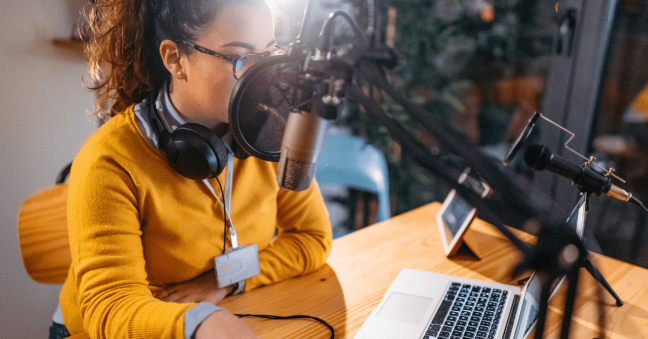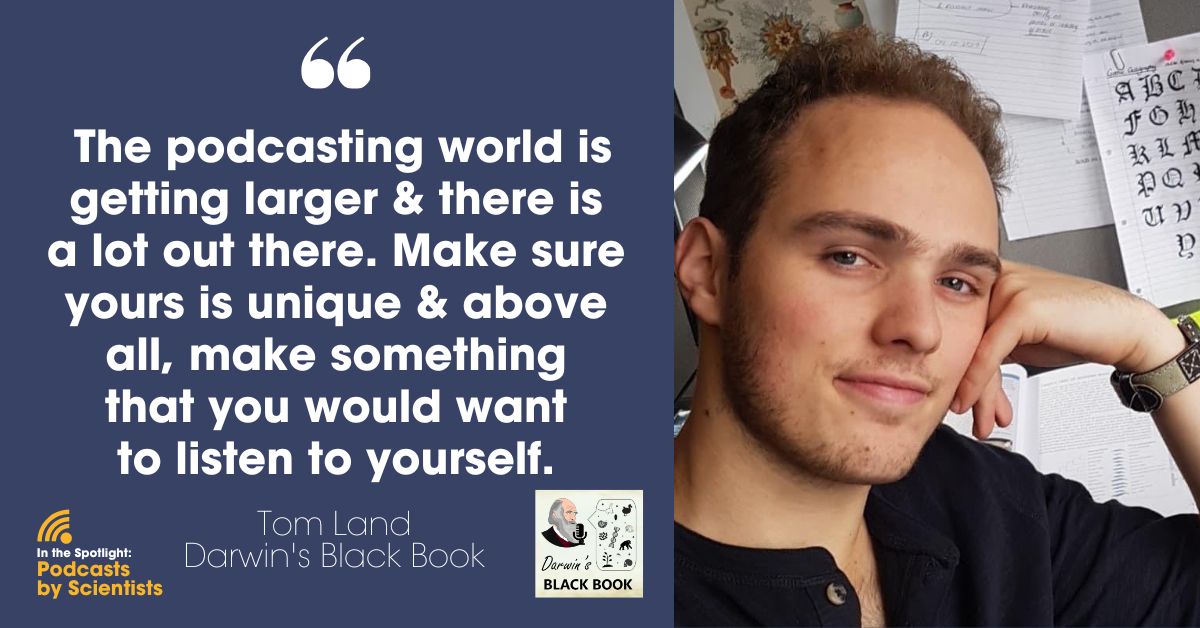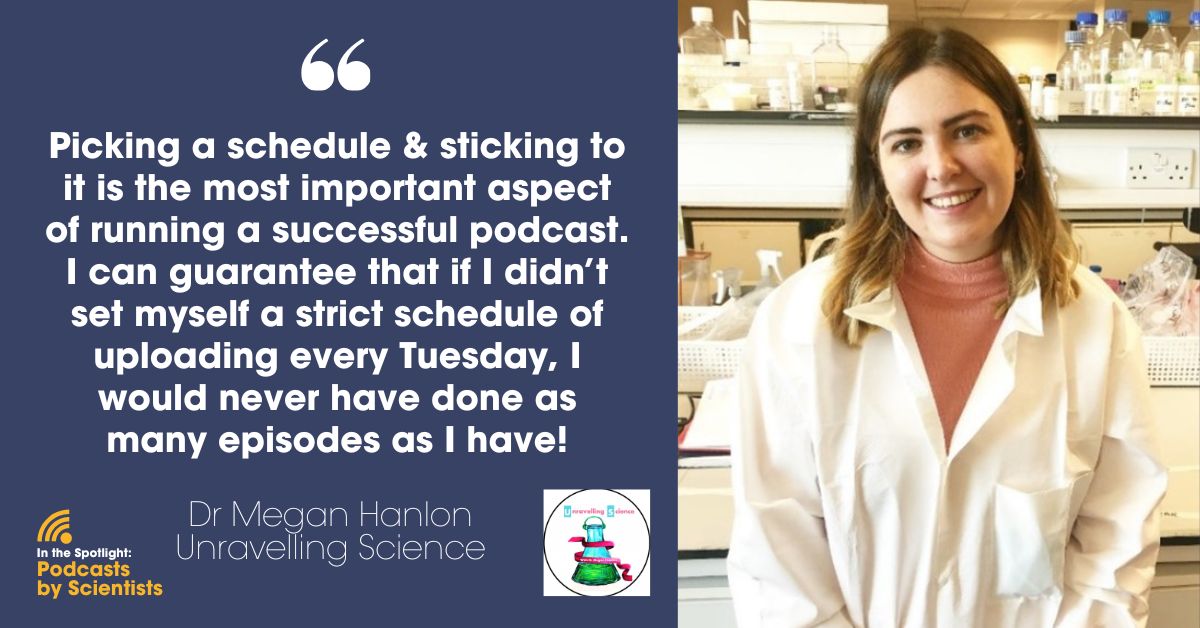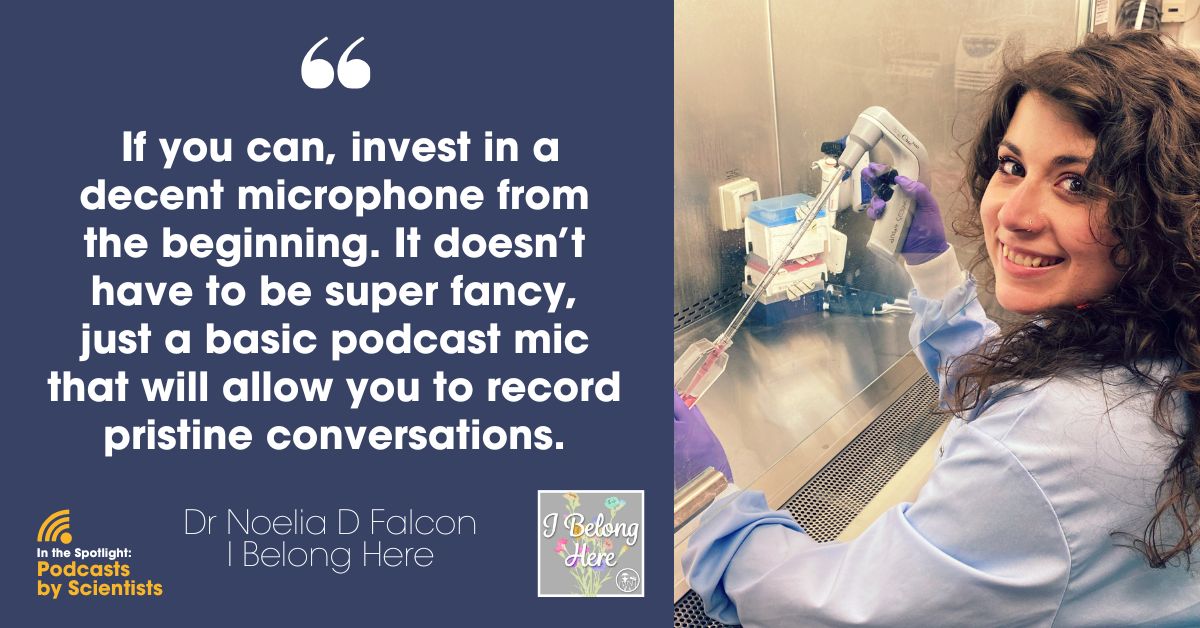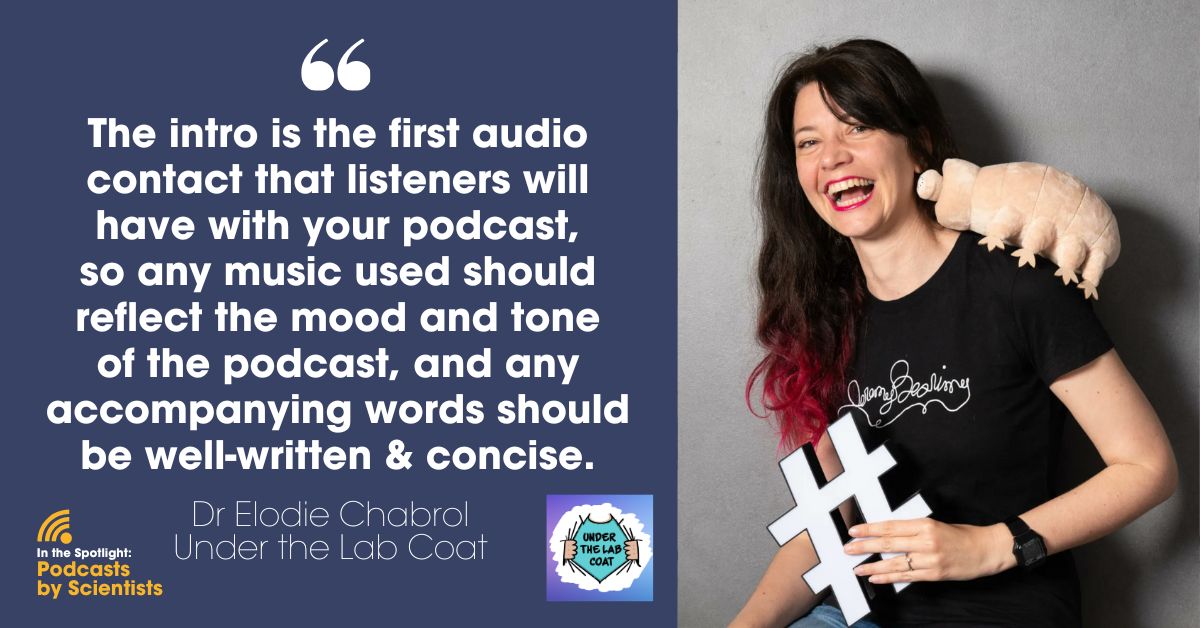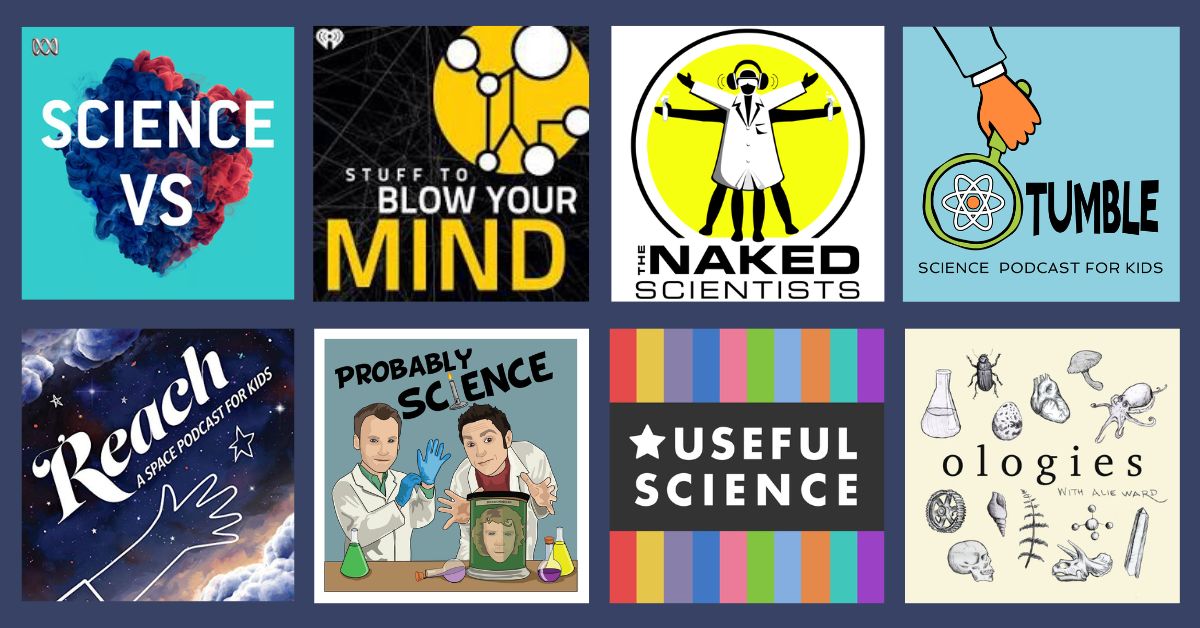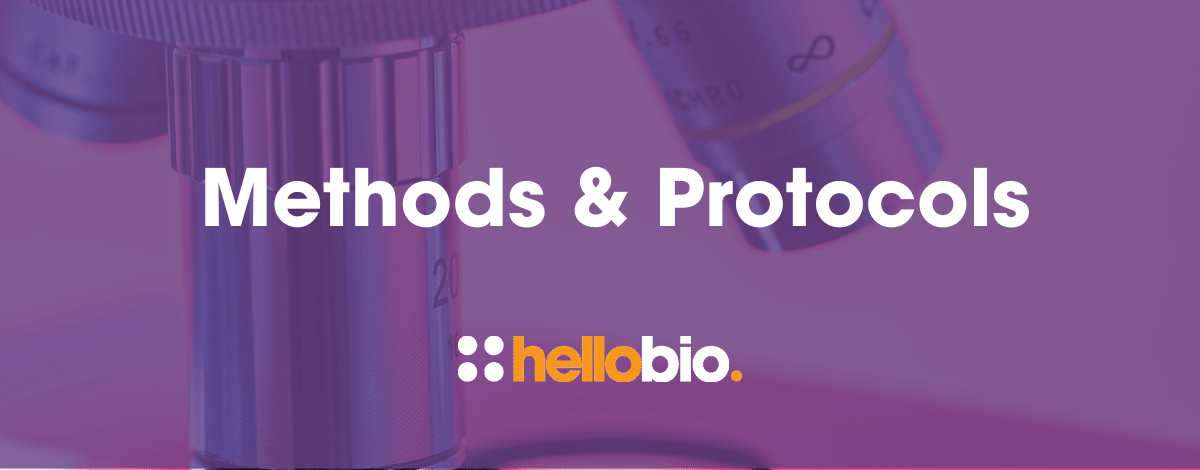Listen & Learn: How to Start Your Own Science Podcast
The podcast is one of the most popular mediums for entertainment and education, and for good reason! Since their launch in the mid-2000s, podcasts have exploded in popularity, offering bite-size, portable audio packages on a seemingly infinite number of topics. No matter what your area of interest there’ll be a podcast out there for you!
Of course the subject of science is well-represented in the podcasting world. From in-depth academic explorations to light-hearted, comedic takes on life in the lab, the choice of podcasts made by scientists is ever-expanding. From Professor Brian Cox’s Infinite Monkey Cage to Bill Nye’s Science Rules!, there truly is something for everyone out there!
If you’ve ever thought about creating your own science-themed podcast but aren’t sure where to start, freelance science communicator and host of the Under the Lab Coat podcast Dr Elodie Chabrol has put together this handy collection of tips and tricks to help you get your podcast off the ground and into the ears of science fans around the world!
Featuring advice on tech, branding, formatting and editing, plus bonus tips from the experienced podcasters featured in our Podcasts by Scientists interview series, this article is guaranteed to help you kick-start your science podcast and make sure it stands out from the crowd!
Take it from the top
So you’re bursting with ideas and keen to get going, but before embarking on the creation of a science podcast, it’s good not to rush things. Take the time to reflect on the strategy you will use, and create an effective step-by-step plan of action.
1. Selecting a subject
Identify what you want to talk about, what content you will include and the messages you want to convey. You must think about the subject over the long-term to be sure you’ll have enough content to last several episodes or seasons. Take a look at the science podcasts that already exist to ensure you’re not duplicating something that’s already been done by others. Of course there’s always room for healthy competition, but coming up with a unique angle on an existing topic will give you a great headstart when it comes to promoting your podcast.
For the best chance of podcast success, ensure the subject you choose is something you’re truly passionate about and that excites you. If you’re not enthusiastic about your topic, it will come across that way to the listeners and they won’t engage with you in the way you want them to.
Dr Noelia D. Falcon, creator and host of the I Belong Here podcast said: “Define your idea very well, ensure it’s something that you see people engaging with. I had a clear vision about my message, and the structure/aesthetics of the podcast came afterwards.”
Tom Land of Darwin’s Black Book also said: “The podcasting world is getting larger and there is a lot out there. Make sure yours is unique, and above all, make something that you would want to listen to yourself.”
2. Choosing a name
Be sure to choose a title that will reflect your chosen subject clearly and concisely. However, be careful not to choose a too restrictive name which may prevent you from developing your content for the following seasons. As your podcast grows you may want to expand into different areas, so keep your podcast title generic enough to be able to do this, but defined enough that people will find it when searching for specific keywords.
Olivia Grant of The Genomics Lab said: “Definitely find your niche and have a clear plan for what you want your podcast to be about, but make sure this is reflected in your podcast name so that people know what to expect!”
3. Deciding on a format
Once you’ve pinned down a subject and title, next comes to the matter of format. Some questions to ask yourself:
- How often? Will you produce episodes at a regular frequency? Do you have the time to dedicate to a weekly, fortnightly, or monthly podcast?
- How long? Are you comfortable and confident talking for a specific length of time? The average length of a podcast is between 30-40 minutes, so perhaps choose a range to aim for rather than a fixed duration which may be restrictive and difficult to stick to.
- Who hosts? Will you be the voice of the podcast? Will you work alone or will you have a co-host to share the load?
- Scripted or freestyle? Do you plan to read from a script or will the podcast be more of a natural conversation style?
- Podcast guests? Will you invite guests to be interviewed? If so, how many and how will you select, approach and liaise with them?
Dr Megan Hanlon of the Unravelling Science podcast said: “I would say picking a schedule and sticking to it is the most important aspect of running a successful podcast. It is so easy for life to get in the way and to think ‘oh sure I’ll upload it next week’. I can guarantee that if I didn’t set myself that strict schedule of uploading every Tuesday, I would never have done as many episodes as I have and I never would have stuck with it.”
Preparation is key
So you’ve decided what to create and you know how you want it to sound, but before launching into your first recording, be sure to prepare well. Good preparation will ensure you don’t have to go back and re-record or fix mistakes further down the line which can be both stressful and time-consuming.
4. Equip yourself for success
To start a podcast, you don’t need expensive equipment to produce audio of reasonable quality. If you’re starting with a low budget, try some very basic recording equipment and consider using free audio enhancement software or apps to improve the recording afterwards. Mobile phone microphones will have sufficient quality for attempting your first recordings. You can even connect a headset with a microphone to your phone or computer and, in a well soundproofed room, record your first episode.
If you do have the budget to invest in a microphone, here are some things to consider:
- At home - a basic USB mic such as the Blue Snowball will allow you to connect directly to your computer and can comfortably record two people chatting across a desk or table.
- On the move - if you’re travelling to another location to record or working with more than one other person, try a ZOOM recorder into which you can connect multiple microphones.
- Online - if you plan to interview someone remotely, the Zencastr platform allows you to prodice good sound with an mp3 track per guest for up to 4 guests in the free version.
Another important thing to consider during your recording is any parasitic noise, eg. outside noise coming from the guests (or from you!) such as keyboard noises, creaking chairs, etc. Ask your guests to sit as still as possible when speaking and especially to try not to bang the table or desk with their hands or elbows! If you have the ability to record one audio track per person, you will have much more freedom in editing if the quality from one audio source is less good than another, or if a specific noise interferes with the interview you may be able to mute that track in places if necessary.
Adriana Wolf Perez of The Caring Scientist podcast, told us how she and her co-host learned a lot about audio recording through online tutorials: “Our audio quality certainly wasn’t the best in our first episodes! We know we are not professional podcasters, however, Nikoline and I are quick learners and are very passionate about our podcast. I recommend looking on YouTube for helpful resources when starting a podcast!”
Dr Noelia D. Falcon also says to ask for help when needed and invest in a mic if you can: “Have someone around to help you with technology if you are as hopeless as I am with fancy equipment and software! If you can, invest in a decent microphone from the beginning. It doesn’t have to be super fancy, just a basic podcast microphone that will allow you to record pristine conversations.”
5. Scripts and storyboards
Before you hit that record button, it's crucial that you already have an outline of your episode in mind. Regardless of whether you opt for a story format or an interview, I strongly advocate creating a storyboard. The least you should do is have a clear idea of the subjects you want to discuss or where and how you want to lead your interview subjects. It’s not always necessary to write down every word you intend to say, but having a good idea of how you see the conversation flowing will prevent awkward pauses from happening. Apps like Milanote offer storyboard templates to help you visualize the flow of each episode.
Bringing your audio to life
However great your recorded conversation may be, good editing is always essential to shape and polish your podcast episode. You’ll want your podcast to sound as professional as possible, and in order to bring out the very best from the content, be prepared to dedicate some time to the editing side of things.
6. The basics of audio editing
It generally takes 3 times the duration of an audio track to edit, ie. if you have an audio track that’s 1 hour long, be prepared to allow around 3 hours to edit it thoroughly.
There are some great pieces of free software available such as Audacity, which if you’re not familiar with audio editing will take a little getting used the first time, but there are many tutorials online to help you learn how to use almost all the features. Once you get used to it, it will seem very simple! If you work in an Apple environment, you can use GarageBand which is also free and slightly easier to use.
Some questions to consider when editing:
- Are the output volumes balanced? If you’re using more than one source of audio input, are the volumes set at similar levels? Make sure both voices are balanced well.
- Do you want to add any sound effects, transitions or backing tracks?
- What type of audio ‘cleaning’ do you plan to do? ie. how will you remove any unwanted silences?
Editing can be fun but don’t get too carried away! Don’t try to make it perfect, as hesitations can be part of the spontaneity, especially if you have an interview format. Sometimes you cannot remove certain parts because doing so would remove the natural tone of the conversation or cut a sentence mid-breath which would be too obvious.
Nikoline Borgermann of The Caring Scientist podcast stresses the importance of not trying to make your podcast perfect: “We struggled with our perfectionism in the beginning but quickly realized that we would never release any episodes if we let perfectionism dictate our work. Progress is more important than perfection - and you will learn quickly!”
Dr Simona Carbone of The Lead Candidate podcast agrees: “Don’t get stuck on making it perfect, just get it done and figure out what does or doesn’t work later on. The majority of podcasts that are just starting out get stuck on these points and never get produced. So, if you love your idea just go with what you have and get it out there.”
7. Adding intros and outros
The intros and outros are the sound or music sections at the beginning and end of the podcast (usually about 30 seconds in length). The intro is the first audio contact that listeners will have with your podcast, so any music used should reflect the mood and tone of the podcast, and any accompanying words should be well written and concise. It’s sometimes quite effective to have the intro recorded by a different voice than the host.
The outro section allows you to thank the listeners and any sponsors, and this is where you can also ask listeners to share or rate your podcast on streaming platforms. It’s okay for the intro and outro to be the same in each episode - you don’t need to record fresh versions unless you have some new information to add.
When it comes to choosing the music for your podcast, there are different platforms that give you the license for a project like Envato Elements or similar royalty-free music sites. Think of your intro music as your podcast’s ‘theme tune’ - it should be something catchy and memorable that your listeners are happy to hear again and again!
Branding and promotion
The audio work is complete and you’re happy with how your podcast sounds, but what about how it looks? Before you launch your new science podcast you need to think about designing and producing some accompanying artwork and possibly a logo to tie all of your promotional material together.
8. Artwork and cover images
Your podcast artwork is its visual identity, and you will need a cover image, in square format, as the visual that will be displayed on the listening platforms. Most podcast artwork features a logo of some sort, with the podcast title and sometimes a tagline or the name of the host.
To create these visuals, you can hire an internal/external graphic designer or do it yourself on simple design sites like Canva. As with your title music, the artwork should reflect the mood and tone of the podcast, but should be eye-catching enough to help you stand out in a very crowded podcast market!
Some great examples of great science podcast cover images:
9. Making the most of social media
Once your podcast is finished and ready to launch, social media is the quickest and easiest way to let people know about it! If you’re already a user of Facebook, Twitter or Instragam, consider setting up brand new accounts dedicated to your podcast. Use your cover image as your profile picture and post about your podcast, both before and after the launch. If possible, take photos or video recordings from ‘behind the scenes’ of your podcast recordings. This gives social media followers a more ‘exclusive’ insight into the making of the podcast and will help them feel more connected to you and your project.
If you are able to film the entire podcast recording and are happy with footage, consider posting teaser video ‘snippets’ before the launch of each episode to pique their interest.
Hosting and releasing your podcast
The final decision you need to make is where to host your podcast. There are many podcast hosting platforms like Acast, Anchor or Ausha which, once connected, will add each new episode to bigger listening platforms like Spotify, Apple Podcasts, Google Podcasts, etc. Take the time to look at which one is best for you and consider all their features.
10. Shouting about it
Once it’s published and you have a link to share, it’s time to shout about your new science podcast! In addition to your social media channels, consider the following:
- Creating a simple website dedicated to your podcast
- Starting a mailing list to keep people updated about forthcoming episodes
- Using transcribing software such as Otter to turn your podcasts into blog articles - this increases accessibility and creates two pieces of content from one source
- Batch-recording the first 4 or 5 episodes so on your first release date you have plenty of content ready to release to the public
And finally...
Enjoy the process! Have a go and see if podcasting is for you!
Carla D’Avanzo of Science Rehashed says: “Surround yourself with passionate, skilled people. It is not easy, it requires time and patience, and it may not pay back in terms of money, but it rewards with the love and recognition of your listeners and guests.”
About the author
Dr Elodie Chabrol is a freelance science communicator and the host of the Under the Lab Coat science podcast. She is a former Neuroscience researcher who completed her PhD in Paris and worked for 8 years in London, during which time she founded the Pint of Science festival in France. She left lab work in 2017 in order to help scientists share their fascinating stories and spread their love of science to the public. Her mission is to make science accessible to everyone, everywhere! Take a look at her website, connect with her on Instagram, Twitter, LinkedIn or by email: contact@elodiechabrol.com
__________________________________________________
If you enjoyed this article, why not check out the other resources available on our blog. We are passionate about supporting life scientists including early career life scientists and PhD students - with really low-priced reagents, antibodies and biochemicals, early career scientist grants, and resources to help with both personal and professional development. We know how tough it is - so we hope you find these helpful!
More General Support for Life Scientists
For advice on wellbeing, dissertations, presenting at conferences, wellbeing, PhD support, networking and lots more, we have a huge range of articles to help - just click below:
Save up to 50% on our high purity reagents...
When you get to the stage of planning your experiments, don't forget that we offer a range of low-cost, high-purity agonists, antagonists, inhibitors, activators, antibodies and fluorescent tools (yes - they really are around half the price of other suppliers!) You can use our Quick Multi-Search Tool to search for lots of products in one go, and the range includes:
- Enzyme inhibitors and activators
- Chemogenetic ligands
- Ion channel modulators
- GPCR & ionotropic receptor ligands
- Cell biology reagents & biochemicals
Technical resources
Try our Molarity Calculator: a quick and easy way to calculate the mass, volume or concentration required for making a solution.
Try our Dilution Calculator: an easy way to work out how to dilute stock solutions of known concentrations
We also offer a comprehensive range of technical resources including antibody protocols and methods, product guides and mini-reviews:
And finally, don't forget to check back in with our blog regularly for our latest articles. If there’s something you’d love to contribute to the community, whether that’s an interview or article, drop us a line at hello@hellobio.com
---





